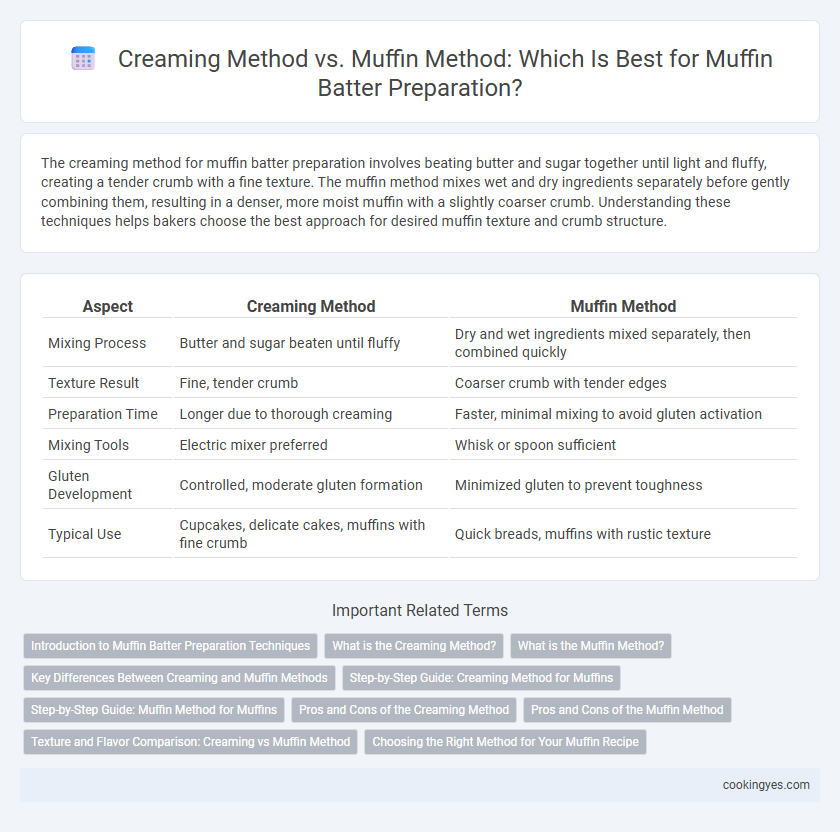The creaming method for muffin batter preparation involves beating butter and sugar together until light and fluffy, creating a tender crumb with a fine texture. The muffin method mixes wet and dry ingredients separately before gently combining them, resulting in a denser, more moist muffin with a slightly coarser crumb. Understanding these techniques helps bakers choose the best approach for desired muffin texture and crumb structure.
Table of Comparison
| Aspect | Creaming Method | Muffin Method |
|---|---|---|
| Mixing Process | Butter and sugar beaten until fluffy | Dry and wet ingredients mixed separately, then combined quickly |
| Texture Result | Fine, tender crumb | Coarser crumb with tender edges |
| Preparation Time | Longer due to thorough creaming | Faster, minimal mixing to avoid gluten activation |
| Mixing Tools | Electric mixer preferred | Whisk or spoon sufficient |
| Gluten Development | Controlled, moderate gluten formation | Minimized gluten to prevent toughness |
| Typical Use | Cupcakes, delicate cakes, muffins with fine crumb | Quick breads, muffins with rustic texture |
Introduction to Muffin Batter Preparation Techniques
Creaming and muffin methods are two fundamental techniques for preparing muffin batter, each affecting texture and rise differently. The creaming method involves beating butter and sugar until light and fluffy, incorporating air that yields a tender, cake-like crumb. In contrast, the muffin method mixes wet and dry ingredients separately before combining gently to avoid overmixing, resulting in a denser, coarser crumb ideal for traditional muffins.
What is the Creaming Method?
The creaming method for muffin batter preparation involves beating butter and sugar together until light and fluffy, creating a stable air foam that improves texture and volume. This technique allows for better gluten development and even distribution of ingredients, resulting in tender and fine-crumb muffins. Unlike the muffin method, which simply mixes wet and dry ingredients, the creaming method requires more time and effort but enhances overall muffin quality.
What is the Muffin Method?
The Muffin Method involves mixing dry ingredients separately from wet ingredients before combining them just until moistened to avoid overmixing and ensure a tender crumb. This technique differs from the Creaming Method, which involves beating butter and sugar together to incorporate air for a lighter texture. Using the Muffin Method helps produce muffins with a denser, moist crumb and a slightly irregular crumb structure.
Key Differences Between Creaming and Muffin Methods
The creaming method involves beating butter and sugar until light and fluffy, creating a stable mixture that traps air for a tender crumb, while the muffin method mixes wet and dry ingredients separately before combining with minimal mixing to prevent gluten development. The creaming method produces a finer, more cake-like texture, whereas the muffin method yields a coarser, denser crumb with a slightly irregular texture. Key differences include ingredient temperature, mixing technique, and the resulting batter consistency, which directly impact the muffin's rise and texture.
Step-by-Step Guide: Creaming Method for Muffins
The creaming method for muffin batter preparation involves first beating softened butter and sugar together until light and fluffy, which incorporates air for a tender crumb. Next, eggs are added one at a time, followed by alternating additions of dry ingredients and liquids, ensuring a smooth, well-incorporated batter. This step-by-step approach enhances texture and rise compared to the simpler muffin method, which mixes wet and dry ingredients separately before combining.
Step-by-Step Guide: Muffin Method for Muffins
The muffin method involves combining dry ingredients first, then mixing wet ingredients separately before gently folding them together to avoid overmixing and ensure a tender crumb. This step-by-step guide includes mixing dry ingredients like flour, sugar, baking powder, and salt in one bowl, whisking wet ingredients such as eggs, milk, and melted butter in another, then slowly incorporating the dry mixture into the wet while stirring just until moistened. This method prevents gluten overdevelopment, resulting in moist, soft muffins with a slightly coarse texture distinct from the creaming method's finer crumb.
Pros and Cons of the Creaming Method
The creaming method for muffin batter preparation creates a light, tender crumb by thoroughly beating butter and sugar to incorporate air, enhancing volume and texture. This method offers superior flavor development and a finer crumb compared to the muffin method but requires precise mixing time to avoid over-creaming, which can lead to dense or greasy muffins. However, the creaming method is more time-consuming and less forgiving for beginners, as improper technique can negatively impact muffin rise and texture.
Pros and Cons of the Muffin Method
The Muffin Method involves mixing wet and dry ingredients separately before combining, which minimizes gluten development for a tender, moist crumb ideal for muffins. This method is faster and less labor-intensive than the Creaming Method, reducing the risk of overmixing and resulting in a finer texture. However, it can produce slightly less rise and lighter crumb structure compared to the Creaming Method, which incorporates more air for volume.
Texture and Flavor Comparison: Creaming vs Muffin Method
The creaming method, which involves beating butter and sugar until light and fluffy, produces muffins with a finer crumb and richer flavor due to better air incorporation and sugar caramelization. In contrast, the muffin method, combining wet and dry ingredients separately before minimal mixing, yields a coarser texture and a denser, more tender crumb with a milder flavor profile. The creaming method enhances volume and moistness, while the muffin method prioritizes ease and a tender, less structured texture.
Choosing the Right Method for Your Muffin Recipe
Choosing the right method for your muffin recipe hinges on the desired texture and crumb structure. The creaming method, which involves beating butter and sugar together, produces a lighter, finer crumb ideal for cake-like muffins. In contrast, the muffin method, combining wet and dry ingredients separately before mixing, yields a denser, tender crumb perfect for traditional, rustic muffins.
Creaming method vs Muffin method for muffin batter preparation Infographic

 cookingyes.com
cookingyes.com